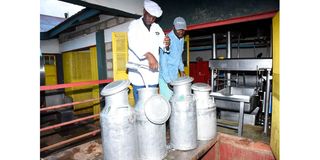Breaking News: Ruto postpones school reopening indefinitely due to flooding
Milk intake at 40-month low as high prices put-off consumers

Reuben Rono (left), an employee at Tarakwo Dairies in Tarakwo, Uasin Gishu County does a quality check on milk delivered by farmers.
The intake of milk by Kenyan households dropped to the lowest level in more than three years in March after milk prices shot up due to low production, hurting purchases in an economy subdued by inflationary pressures.
Latest data from the Kenya Dairy Board (KDB) shows milk intake dropped to 52.19 million litres in March – the lowest in 40 months since October 2019 when intake reduced to just 51.3 million litres.
This marks the second consecutive monthly drop in milk intake after consumption of the drink fell from 62.08 million litres in January to 52.21 million litres in February.
Overall, milk consumption has dropped by 15.7 per cent in the first three months of 2023 with total consumption reducing to 166.49 million litres compared to 197.54 million litres in the same quarter last year.
This sets milk consumption figures for 2023 on course to be lower than those recorded last year driven by local production shortage as the cost of inputs went up amid a biting drought.
Data from the dairy board shows milk intake dropped by 6 per cent to 754.34 million litres in 2022 down from a record high consumption of 801.91 million litres in 2021.
The statistics cover milk consumed by the formal sector.
The informal milk market is however estimated to account for about 60 per cent of Kenya's milk market.
Insufficient data
This has left the government with insufficient data not only about the dealers in the informal market but also about the quality and safety of the milk.
Milk production in the country is estimated at 5.2 billion litres per year with an estimated 1.8 million smallholder dairy farmers, who produce over 80 per cent of the milk.
"Milk uptake in the formal sector dropped from 52.21 million litres in February 2023 to 52.19 million litres in March 2023," said the report.
Milk prices have shot up in recent months as farmers struggle to feed their dairy cows due to high prices of grass and other inputs.
A litre of fresh unpackaged milk was retailing at an average price of Sh73.47 in March this year, an increase of 19.2 per cent from a price of Sh61.61 per litre in March 2022, according to data from the Kenya National Bureau of Statistics (KNBS).
The high prices have forced some households to reduce their intake of the drink or drop it entirely at a time the prices of other commodities such as maize flour, sugar, and cooking oil have also risen sharply.
The informal milk market is estimated to account for about 60 per cent of Kenya's milk market which has left the government with insufficient data not only about the dealers in the informal market but also the quality and safety of the milk.
Kenya has been facing challenges producing enough milk to satisfy demand due to droughts that have worsened in recent years affecting fodder production coupled with the increased cost of other dairy inputs.
The shortage has seen an influx of milk imports from other countries especially Uganda where it is produced much more cheaply as local milk processors continue to struggle.





